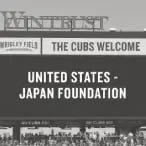Grantee: Center for Independent Documentary (2024)
Project: Diamond Diplomacy

“Baseball was more than just a game—it was a shared passion that had shaped history and opened avenues for mutual understanding,” says Yuriko Gamo Romer, filmmaker and director of Diamond Diplomacy. This feature-length documentary chronicles the history of baseball in Japan and its role in fostering people-to-people diplomacy between Japan and the United States. By blending sports history with cultural exchange, the film offers a rich narrative of how baseball has united two nations across political and cultural divides for more than a century.
A Filmmaker's Journey
Yuriko Gamo Romer’s path to Diamond Diplomacy began with her long-standing fascination with Japanese American connections and her belief in storytelling as a tool for fostering understanding. As an award-winning filmmaker, she was already known for Mrs. Judo: Be Strong, Be Gentle, Be Beautiful, a documentary celebrating the life of Keiko Fukuda, the first woman to attain judo's highest rank (10th-degree black belt). Her collaboration with the US-Japan Foundation on Mrs. Judo laid the foundation for a new project that would also bridge cultures.
The idea for Diamond Diplomacy was sparked by an unlikely source: a story shared by Dave Dempsey, whose father pitched for the Pacific League team the San Francisco Seals and later played a role in post-war diplomacy in Japan under General MacArthur. “The 1949 tour by Dave’s father and his team was a turning point for me,” Romer recalls. “It wasn’t just a baseball story; it was about diplomacy and connection.”
From the introduction of baseball to Japan in 1872 by an American teacher to the modern-day stardom of Japanese players like Ichiro Suzuki and Shohei Ohtani, the sport provides a compelling lens to examine US-Japan relations.
Challenges in the Field
While the vision for Diamond Diplomacy was clear, bringing it to life was no small feat. Funding posed one of the most significant challenges. Romer credits the US-Japan Foundation’s early support as pivotal. “Without their initial grant, there’s no way this film would exist,” she emphasizes. The seed money enabled Romer to begin the daunting work of gathering archival footage, filming interviews and events, and shaping the documentary’s narrative.
 However, even with foundational support, financial hurdles remained. “Crowdsourcing helped us raise $40,000, which was great,” Romer says. “But that’s just a drop in the bucket for a documentary of this scale.” A $600,000 grant from the National Endowment for the Humanities (NEH) eventually gave the project the boost it needed, but other challenges loomed.
However, even with foundational support, financial hurdles remained. “Crowdsourcing helped us raise $40,000, which was great,” Romer says. “But that’s just a drop in the bucket for a documentary of this scale.” A $600,000 grant from the National Endowment for the Humanities (NEH) eventually gave the project the boost it needed, but other challenges loomed.
Navigating Major League Baseball’s (MLB) licensing requirements proved particularly complicated and costly for an independent film. “I realized there was no way to do this film without MLB’s involvement,” Romer explains. Securing rights to historical footage, such as Masanori Murakami’s games for the San Francisco Giants, and obtaining permission to film in MLB venues required persistence, negotiation, and significant financial investment. “Even footage we filmed ourselves at an MLB ballpark had to be licensed through MLB,” she notes.
The Game-Changing Impact of Baseball
 Despite these challenges, Diamond Diplomacy has become a testament to the power of sports as a vehicle for cultural diplomacy. The film delves into key historical moments, such as Babe Ruth’s celebrated 1934 Japan tour, which cemented baseball’s popularity in the country. Ruth’s charisma and talent made him a symbol of goodwill, even amid rising political tensions.
Despite these challenges, Diamond Diplomacy has become a testament to the power of sports as a vehicle for cultural diplomacy. The film delves into key historical moments, such as Babe Ruth’s celebrated 1934 Japan tour, which cemented baseball’s popularity in the country. Ruth’s charisma and talent made him a symbol of goodwill, even amid rising political tensions.
Another milestone featured in the documentary is Masanori Murakami’s debut as the first Japanese player in Major League Baseball. Murakami’s 1964 season with the San Francisco Giants marked a breakthrough moment in sports history.
“Baseball is a universal language,” Romer reflects. “It’s a way to transcend barriers and bring people together.” This sentiment is at the heart of Diamond Diplomacy, which seeks to remind audiences of the deep connections between Japan and the United States, forged not through treaties or trade deals but through a shared love of the game.
A Broader Vision
While Diamond Diplomacy explores historical milestones, it also highlights lesser-known stories, such as the role of baseball during Japan’s post-war reconstruction. General MacArthur’s decision to send an American baseball team to Japan as part of his Allied occupation strategy is a prime example of sports being used to heal and rebuild relationships.
The documentary also sheds light on cultural differences and similarities through the lens of baseball. For example, while American baseball often emphasizes individual performance and showmanship, Japanese baseball is more focused on teamwork and discipline. These contrasting approaches reflect broader cultural values and offer insights into the ways the two nations influence and learn from each other.
Looking Ahead
 With the documentary nearing completion, Romer is eager to share Diamond Diplomacy with audiences worldwide. Plans include submitting the film to major international film festivals and organizing community screenings in both the United States and Japan. Romer hopes these screenings will spark conversations about the enduring power of sports diplomacy and inspire future collaborations.
With the documentary nearing completion, Romer is eager to share Diamond Diplomacy with audiences worldwide. Plans include submitting the film to major international film festivals and organizing community screenings in both the United States and Japan. Romer hopes these screenings will spark conversations about the enduring power of sports diplomacy and inspire future collaborations.
The project’s educational potential is also significant. By working with museums, schools, and cultural organizations, Romer envisions Diamond Diplomacy becoming a resource for teaching about history, culture, and the importance of international understanding.
“This isn’t just a film about baseball,” Romer concludes. “It’s about relationships—how something as simple as a game can bridge divides and bring people together.”
Through her dedication and the early support of the US-Japan Foundation, Yuriko Gamo Romer has created a documentary that not only celebrates a shared love of baseball but also underscores its power to connect, heal, and inspire.
← Back to January 2025 grantees




